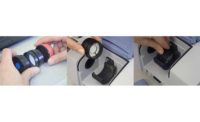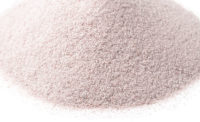Scientists at the National Institute for Occupational Safety and Health (NIOSH) have developed a novel technique that makes it possible to measure silica dust quickly and easily at the mine site.
Silica dust exposure can causes silicosis, an irreversible, but preventable, occupational lung disease.
The lead author of the study, Emanuele Cauda, Ph.D., NIOSH senior service fellow, explained the new technique in NIOSH's March Research Rounds.
Q: Why is early silica monitoring important?
A: Avoiding silica exposure is a special challenge for miners. To monitor that exposure and create the best control intervention, health and safety managers at mines periodically take dust samples to check for silica levels. They have a single, pressing question: “What are the silica concentrations in these samples?” Having a quick answer would allow mines to take immediate action to reduce high dust concentrations. Currently, however, mines must send the dust samples off for analysis and wait 1–3 weeks for the results. Also, the conditions and dust concentrations in mines are constantly changing, so by the time the results arrive, the mine might not be able to take effective action. We need a better way to protect miners’ health.
Q: How does the new technique work?
A: At NIOSH, we have developed a new monitoring approach that builds on the existing sampling devices commonly used by health and safety professionals in mines. First, we take a dust sample in the mine. Then we remove the sampling cassette and place it in a small, portable instrument. The instrument uses an infrared technique, based on NIOSH-developed models, to measure the silica in the sample in less than 1 minute. This way, we get quick results right on-site in the mine. Also, the mine benefits financially in the long run by making the initial investment in a reusable instrument, rather than paying each time a sample is sent for analysis.
Q: What are the next steps?
A: We are currently testing several commercially available portable instruments for this approach. After testing more than 350 samples collected in both coal and non-coal mines, we know the technique works, but we need to optimize it. First, we need to refine the analytical technique for samples that contain different minerals together with silica. Second, we need to optimize the physical fit between the sampling cassette and the portable instruments. Finally, we’re developing software to interface with the different commercial portable instruments and to ensure accurate quantifications and calibrations of the measurements.
We are very excited about the potential health benefits from this approach. Now, what we really need is more mines participating with us in field studies, so we can optimize the technique with input from future users. We would be grateful if mine operators and health and safety managers could contact us to talk about how we can work together to help protect workers from silica exposure diseases.
For more information, click the titles below:
Mining Project: Monitoring and Control of Airborne Toxic Substances in Mining
Mining Topic: Exposure Monitoring of Dust and Toxic Substances






